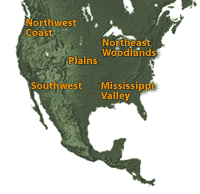|

|
|
The United States
In 1776, the newly formed United States of America joined in the competition for
land. Even though the U.S. government theoretically protected the rights of the
Indians to their homelands, Indian people were coerced into signing treaties that
relinquished their titles to lands. In response to pressure from settlers for
additional land, Congress passed the Removal Bill in 1830, giving President Andrew
Jackson the power to exchange land west of the Mississippi River for Indian
homelands in the Southeast. The western land was loosely described as "an ample
district west of the Mississippi, not within the states of Missouri and Louisiana
or the territory of Arkansas." Those Indian people who voluntarily agree to the
exchange were relocated in an area of present-day Oklahoma. Those who refused were
forcibly removed. The Native people were to be guaranteed rights to the new land
forever in exchange for their homelands.
The Regulation Act of 1834 prohibited non-Indians from settling in Indian lands and
required them to have license to trade with Native Americans, but waves of white settlers
continued to move west across the Mississippi River anyway. Once territories were
established in Iowa and Wisconsin, it became necessary to move the Indian "frontier"
from the Mississippi River to the 95th meridian. The new line extended from the Lake
of the Woods near the Minnesota-Canada border, south through Minnesota and Iowa, along
the western border of Missouri, Arkansas and Louisiana into Texas. Military forts like
Fort Snelling were established to maintain this frontier. (In 1858, Minnesota was made
a state. It extended west of the 95th meridian, 100 miles beyond the "permanent frontier"
of the American Indians.)
The Conquest of the West
The discovery of gold in California in 1848 precipitated another wave of migration along
the Santa Fe and Oregon trails. Settlers and miners overran Indian lands, obliterating
their villages. Through a combination of disease and genocide, an estimated 70,000
Native people died in the west in the decade between 1849 and 1859.
By the outbreak of the Civil War, thirty million Euro-Americans populated the country
to the east of the Mississippi and along the West Coast. A sizeable population of Africans
brought into this country as a result of the slave trade also lived to the east. Although
the war had temporarily slowed the movement of settlers from the east to the west, it was
renewed with even greater force at the war's end. The decades from 1860 to 1890 that gave
rise to the Wild West legends of cowboys, range wars, cattle drives, and homesteaders were
sadly the same time that American Indian people faced the final conquest of their lands.
More about Native American History and Culture
|



